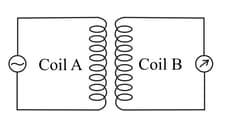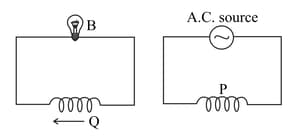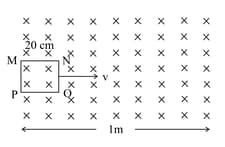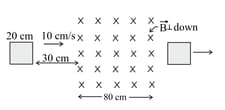The circuit arrangement given in Fig. 6.71 shows that when an a.c. passes through the coil , the current starts flowing in the coil . Mention two factors on which the current produced in the coil depends.



Important Questions on Electromagnetic Induction
Figure 6.72 given below shows an arrangement by which current flows through the bulb (X) connected with coil , when a.c. is passed through coil .

Explain the following observation:
Bulb lights up.
Figure 6.72 given below shows an arrangement by which current flows through the bulb (X) connected with coil , when a.c. is passed through coil .

Explain the following observation:
Bulb gets dimmer if the coil '' is moved upwards.
Figure 6.72 given below shows an arrangement by which current flows through the bulb (X) connected with coil , when a.c. is passed through coil .

Explain the following observation:
If a copper sheet is inserted in the gap between the coils how the brightness of the bulb would change?
A coil is connected to low voltage bulb and placed near another coil as shown in Fig. 6.74. Give reasons to explain the following observation:

The bulb '' lights.
A coil is connected to low voltage bulb and placed near another coil as shown in Fig. 6.74. Give reasons to explain the following observation:

Bulb gets dimmer if the coil is moved towards left.
A square loop of side is placed horizontally in a uniform magnetic field acting vertically downwards as shown in the Fig. 6.75. The loop is pulled with a constant velocity of till it goes out of the field.

(i) Depict the direction of the induced current in the loop as it goes out of the field. For how long would the current in the loop persist?
(ii) Plot a graph showing the variation of magnetic flux and induced emf as a function of time.
A square loop of side is initially kept away from a region of uniform magnetic field of as shown in Fig. 6.77. It is then moved towards the right with a velocity of till it goes out of the field. Plot a graph showing the variation of magnetic flux () through the loop with time ().

